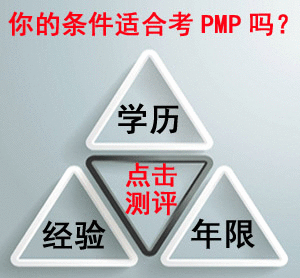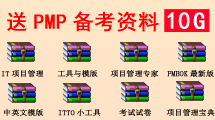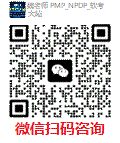1.You have been assigned as project manager on what could be a "bet the company" project. If the project is successful, management will be carrying you around on a sedan chair, if it fails, you will be in the unemployment line. You realize that to be successful you need to exercise maximum control over project resources. Which form of project organization should you establish for this project? A. Strong matrix
B. Projectized
C. Project coordinator
D. Weak matrix
1. 你負責管理的一個項目, 這個項目對你來說是成敗在此一舉。 如果項目成功, 那么你的前途無量;如果項目失敗, 那么你就要被炒魷魚。 你意識到: 為了使項目成功,你必須對項目資源具有最大程度的控制。 那么你預備建立哪一種項目組織形式來達到你的目的
A. 強矩陣
B. 項目型
C. 項目協調人
D. 弱矩陣
2.Your project is managed under a projectized organization. It has just entered closure. Under the circumstances, which of the following should be your GREATEST concern?
A. Setting yourself up to take over a large multi-year project
B. The team is not focused on completing the project.
C. You will have extra pressure from the customer.
D. Making sure your manager knows the project is almost completed
2. 你的項目在項目型組織中執行,現在剛進入收尾階段,在這種情形下你最應該關注的是:
A.讓自己能接受一個大的多年度的項目
B.這個團隊重心不在完成這個項目上
C.你會受到來自客戶的額外壓力
D.確定你的經理知道這個項目已幾乎完成
3. You have been assigned to a project in which the objectives are to direct customer calls to an Interactive Voice Response system before being connected to a live agent. You are in charge of the media communications for this project. You report to the project manager in charge of this project and the VP of marketing, who share responsibility for this project. Which organizational structure do you work in?
A. Functional organization
B. Weak matrix organization
C. Projectized organization
D. Balanced matrix organization
3. 你參與一個項目,該項目目標是在客戶的電話在未被連接到代理之前,將其接到一個交互式的語音回應系統。你主要負責該項目的信息溝通.你需要向該項目的項目經理和市場VP(與項目經理共同分享項目的權限和職責)匯報工作。你所工作的機構屬于下列哪種組織形式?
A. 職能組織
B. 弱矩陣組織
C. 項目化組織
D. 平衡矩陣組織
4. What is not true of project life cycle phases?
A. They are generally sequential
B. They cannot overlap
C. They define what deliverables are produced
D. They involve handoffs to other phases
4. 關于項目生命期各階段的描述哪個是不正確的?
A. 它們通常是順序的
B. 它們不能夠重疊
C. 它們定義了將產生何種可交付成果
D. 它們涉及從某個階段到另一個階段的交接
5. The major difference between the project coordinator and project expeditor forms of organization is that
A. Strong commitment to the project usually does not exist in the project expeditor form of organization
B. The project coordinator cannot personally make or enforce decisions
C. The project expeditor acts only as an intermediary between management and the project team
D. The project coordinator reports to a higher-level manager in the organization
5. 項目協調者類型和項目促進者類型的組織形式之間主要區別在于:
A. 在項目促進者類型的組織形式中,員工們通常對項目沒有比較穩固的承諾
B. 項目協調者通常不能以個人名義做出或執行項目決策
C. 項目促進者只是作為管理層和項目團隊之間的媒介存在
D. 項目協調者負責向組織中更高層的經理人員進行報告
6. Project A is being administered using a matrix form of organization. The project manager reports to a senior vice president who provides visible support to the project. In this scenario, which of the following statements best describes the relative power of the project manager?
A. The project manager will probably not be challenged by project stakeholders.
B. In this strong matrix, the balance of power is shifted to the functional line managers.
C. In this tight matrix, the balance of power is shifted to the project manager.
D. In this strong matrix, the balance of power is shifted to the project manager.
6. A項目通過一個組織矩陣進行管理。 項目經理向一位高級副總裁匯報工作, 后者對項目提供實際的幫助。在這種情況下, 以下哪個陳述最好地說明了項目經理的相對權力?
A. 項目經理很可能不會受到項目干系人的責難
B. 在這個強矩陣中, 權力的平衡傾向于職能經理
C. 在這個緊密矩陣中, 權力平衡傾向于項目經理
D. 在這個強矩陣中, 權力平衡傾向于項目經理
7. At what point in the project would stakeholders have the most ability to influence the final outputs of the project product?
A. Implementation
B. Development
C. Concept
D. Close out
7. 在項目的什么階段,干系人對項目的最終產品影響能力最強?
A. 執行
B. 開發
C. 概念
D. 收尾
8. An organization is going through an evolution phase of restructuring the way it does projects. In a shift from a weak matrix organization to a strong matrix organization, the power is shifted from:
A. Project manager to functional manager.
B. Expeditor to coordinator.
C. Functional manager to project manager.
D. Functional manager to sponsor.
8. 一個組織正處于調整其從事項目工作方式的發展階段。從弱矩陣組織到強矩陣型組織的轉換中,權利的轉移是從
A. 項目經理到職能經理
B. 督辦員到協調員
C. 職能經理到項目經理
D. 職能經理到出資人
9. In a projectized organization the project team:
A. Reports to many bosses.
B. Has no loyalty to the project.
C. Will not always have a home.
D. Will be less interested in the project.
9. 在項目型組織中,項目團隊
A. 向很多老板匯報
B. 對項目不忠誠
C. 不是一直都有“家”
D. 對項目工作不感興趣
10. Which type of organization is BEST for managing complex projects involving cross-disciplinary efforts?
A. Projectized
B. Functional
C. Line
D. Matrix
10. 在管理跨越多個部門的復雜項目時,下列哪種組織類型最有效?
A. 項目型
B. 職能型
C. 部門型
D. 矩陣型
11. In which organization projectmember feel most anxiety at closing phase?
A. Functional
B. Matrix
C. Projectized
D.Strong Matrix
11. 在哪種組織中,項目成員在項目收尾階段最為焦慮?
A. 職能型
B. 矩陣型
C. 項目型
D. 強矩陣型
12. In matrix organizational structures, theprimary condition leading to conf1ict is—
A. Communication barriers
B. Conflicting interests
C. Need for consensus
D. Ambiguous jurisdictions
12. 在矩陣組織結構中,導致沖突的主要情況是:
A. 溝通障礙
B. 相互沖突的利益
C. 需要統一意見
D. 管轄模糊
13. The highest risk impact generally occursduring which of the following project life cycle phases?
A. Concept andplanning
B. Planning and implementation
C. Implementation and closeout
D. Concept and closeout
13. 在以下哪個項目生命周期階段風險的影響最大?
A. 構思和規劃
B. 規劃和執行
C. 執行和收尾
D. 構思和收尾
14.In which kind oforganization structure, does the project expeditor appear?
A. Matrix organization
B. Projectized organization
C. Functional organization
D. Any organization
14. 在哪種組織結構中會出現項目聯絡員?
A.矩陣組織
B.項目型組織
C.職能組織
D.任何組織
15. In the strong and weak matrix structures,the balance of power may be shifted to either the project manager of functionalmanager by changing the:
A. Levels at which the project and theparticipating functional managers report
B. Support provided to the project andfunctional managers from top management
C. Physical distances between the peopleinvolved in the project
D. All the above
15. 在強矩陣與弱矩陣結構中,權力均勢可以通過改變( )轉移到項目經理或職能經理。
A.項目經理及參與項目的職能經理的報告級別
B.高層管理者對項目經理與職能經理的支持
C.項目所涉及人員在空間上的距離
D.上述所有選項
16. Who has the power in a strong matrix?
A. Functional manager
B. Senior management
C. Sponsor
D. Project manager
16. 誰在強矩陣中具有更多的權力?
A.職能經理
B.高級管理層
C.出資人
D.項目經理
17. One of the main advantages of a matrixorganization?
A. Improves project manager control overresources.
B. More than one boss for project team.
C. Communication is easier.
D. Reporting is easier.
17. 下列哪一個是矩陣型組織的主要優點?
A. 它增強項目經理控制資源
B. 它允許項目團隊有不止一個老板
C. 溝通更容易
D.匯報更容易
18. A PM’s boss and the head of engineering discuss a change to a major task.After the meeting, the boss contacts the project manager and tells him go makesome changes. This is an example?
A. A projectcoordinator position
B. Changecontrol board meeting
C. Management attention to time management
D. Management involvement in executing
18. 一位項目經理的老板和工程領導討論一個關鍵任務的變更。會議結束后,該老板與項目經理聯系,告訴他做了一些變更。這是一個什么樣的例子?
A.一位項目協調員的職位
B.變更控制委員會會議
C. 對時間管理的管理關注
D. 管理層參與執行
19. A frequent complaint of matrix organizationsis that communications are:
A. Simple
B. Open and accurate
C. Complex
D. Hard to automate
19. 矩陣組織中常見的一個毛病是溝通:
A. 簡單
B. 公開而準確
C. 復雜
D. 難于自動化
20. The greatest of uncertainty is encounteredduring which phase of the project life cycle?
A. Concept
B. Planning
C. Implementation
D. Closeout
20. 項目生命周期的哪個階段具有最大的不確定性?
A. 概念階段
B. 規劃階段
C. 執行階段
D. 收尾階段
21. Projects have the least attentionin what form of organization:
A. Balanced matrix
B. Strong matrix
C. Coordinator
D. Functional
21. 項目在哪種組織中最不被重視?
A. 平衡矩陣型
B. 強矩陣型
C. 協調者
D. 職能型
22. The terms strong matrix, balanced matrix,and weak matrix when applied to the matrix structure in project organizationrefer to the
A. Ability of theorganization to achieve its goals
B. Physical proximity of project team members toone another and to the project manager
C. Degree of authority the project manager hasover team resources
D. Degree to which team members bond together
22. 當對項目組織的矩陣結構采用強矩陣, 平衡矩陣和弱矩陣等詞匯時, 它們指的是:
A. 組織達成目標的能力
B. 項目小組成員之間的物理距離以及與項目經理的物理距離
C. 項目經理對項目小組資源的控制能力
D. 項目小組成員合作的程度
23. Which phase is influenced highest by thestakeholders?
A. Concept
B. Development
C. Execution
D. closeout
23. 項目干系人對項目最大的影響力在:
A. 概念階段
B. 開發階段
C. 執行階段
D. 結束階段
24. A project stakeholder may include:
A. End users
B. Suppliers
C. Citizens
D. All of the above
24. 項目干系人可能包括:
A. 最終用戶
B. 供應商
C. 市民
D. 所有上述選項
25. The amount of authority a project managerpossesses can be related to:
A. The project manager's communication skills
B. The organizational structure
C. The amount of authority the manager of theproject manager possesses
D. The project manager's influencing skills
25. 項目經理擁有的權力與什么有關?
A.項目經理的溝通技能
B.組織結構
C.項目經理的領導所擁有的權力
D.項目經理的影響能力
26. At the first phase end of the project, youshould ensure that_____ before you begin the next phase.
A. Resources are available for the next phase.
B. Progress was achieved to its baseline.
C. The phase has reached the objectives andformally accepts its deliverables.
D. Corrective actions are taken to bring projectresults
26. 在項目第一階段末,在你開始下一階段前,應確保_____
A.下一階段的資源能得到
B.進程達到它的基準
C.該階段達到了目標,并且可交付成果已正式接收
D.采取糾正措施獲得項目結果
27.You are a project manager for a largeconstruction project when you realize that there are over 500 potentialstakeholders on the project. Which of the following would be the BEST course ofaction for you to take?
A. Eliminate some stakeholders
B. Find an effective way to gather the needs ofall stakeholders
C. Gather the needs of all the most influentialstakeholders
D. Contact your manager and ask which ones aremore important
27. 作為一個大型建設項目的項目經理,你認為到項目有500多個可能是干系人。下列做法中,你最好應采取哪一個行動方案?
A. 排除一些干系人
B. 找到一個收集所有干系人需求的有效途徑
C. 收集所有最具影響力的干系人的需求
D. 聯系你的經理,問哪位更重要
28. Who of the following are alwaysstakeholders?
A. A person who does not want the project to becompleted
B. An assembly line worker that will use theproduct of the project
C. A functional manager from the engineeringdepartment
D. A person who might lose their position in thecompany because of the project
28. 下列誰總是干系人?
A. 不希望項目完工的人
B. 將使用項目產品的裝配線工人
C.來自工程部的職能經理
D.可能因項目而失去公司中職位的人
29. Project expeditor is different from a project coordinator in that it:
A. can make more decisions
B. reports to a higher-level management
C. can make no decisions
D. has some authority
29. 項目聯絡員與項目協調員的不同點在于其:
A.可以制訂更多的決策
B.向更高層管理者報告
C.不能制訂決策
D.有一些權限
30. An important concept in project managementis holding reviews at the conclusion of major project phases. Which of thefollowing is not a name commonly used for these reviews?
A. Phase review
B. Benchmarks
C. Stage gates
D. Kill points
30. 項目管理的一個很重要的概念就是在主要的項目階段結束之際舉行評審,這種評審的名稱不包括哪一個?
A. 階段審查
B. 標桿參照
C. 階段把關
D. 生死點
PMBOK指南(第5版)第二章習題 參考答案
1.
參考答案:B
知識要點:項目型組織結構,項目經理權力最大,控制資源能力最強
資料來源:《PMBOK指南》第5版第22頁,或培訓講義第29頁
2.
參考答案:B
知識要點:項目型組織結構的缺點,團隊成員沒有家的歸屬感
資料來源:《PMBOK指南》第5版第25頁,或培訓講義第28頁
3.
參考答案:D
知識要點:平衡矩陣組織結構中,項目經理和職能經理權力一樣大
資料來源:《PMBOK指南》第5版第22頁,或培訓講義第26頁
4.
參考答案:B
知識要點:項目生命周期各階段可以按順序排列,也可以交疊
資料來源:《PMBOK指南》第5版第41頁,或培訓講義第35頁
5.
參考答案:D
知識要點:項目協調員可以向更高層匯報,有一定的決策權
資料來源:《PMBOK指南》第5版第23頁,或培訓講義第24-25頁
6.
參考答案:D
知識要點:項目經理向更高層匯報,說明權力大于職能經理,是強矩陣組織結構
資料來源:《PMBOK指南》第5版第22頁,或培訓講義第29頁
7.
參考答案:C
知識要點:項目干系人的影響力在開始最大,隨項目進展而減弱
資料來源:《PMBOK指南》第5版第40頁,或培訓講義第35頁
8.
參考答案:C
知識要點:弱矩陣組織結構,職能經理權力大于項目經理;強矩陣組織結構,項目經理權力大于職能經理
資料來源:《PMBOK指南》第5版第22頁,或培訓講義第29頁
9.
參考答案:C
知識要點:項目型組織結構的缺點,團隊成員沒有家的歸屬感
資料來源:《PMBOK指南》第5版第25頁,或培訓講義第28頁
10.
參考答案:D
知識要點:矩陣型組織結構的優點,可以跨部門合作、溝通
資料來源:《PMBOK指南》第5版第23頁,或培訓講義第29頁
11.
參考答案:C
知識要點:項目型組織結構,團隊成員沒有家的感覺
資料來源:《PMBOK指南》第5版第25頁,或培訓講義第28頁
12.
參考答案:D
知識要點:矩陣型組織結構有二個領導:項目經理和職能經理,導致管轄模糊
資料來源:《PMBOK指南》第5版第23頁,或培訓講義第27頁
13.
參考答案:C
知識要點:風險的影響在項目開始小,隨之增加
資料來源:《PMBOK指南》第5版第40頁,或培訓講義第35頁
14.
參考答案:C
知識要點:項目經理在職能型組織或弱矩陣組織結構的角色是項目協調員或聯絡員
資料來源:《PMBOK指南》第5版第23頁,或培訓講義第28頁
15.
參考答案:D
知識要點:強、弱、平衡矩陣組織中劃分的依據,是項目經理與職能經理的權力大小
資料來源:《PMBOK指南》第5版第22頁,或培訓講義第29頁
16.
參考答案:D
知識要點:強、弱、平衡矩陣組織中劃分的依據,是項目經理與職能經理的權力大小
資料來源:《PMBOK指南》第5版第22頁,或培訓講義第29頁
17.
參考答案:A
知識要點:組織結構的優缺點,默認是與職能型組織相比。與職能型組織相比,矩陣型組織中項目經理的權力要大一些,對資源的控制能力要強一些
資料來源:《PMBOK指南》第5版第22頁,或培訓講義第29頁
18.
參考答案:A
知識要點:項目經理應該參與變更管理。如果項目經理沒有直接參與變更管理,說明權力太小,只是一個協調員或者聯絡員的角色
19.
參考答案:C
知識要點:矩陣型組織結構有二個領導:項目經理和職能經理,導致溝通復雜
資料來源:《PMBOK指南》第5版第23頁,或培訓講義第27頁
20.
參考答案:A
知識要點:項目開始,很不確定,風險大
資料來源:《PMBOK指南》第5版第40頁,或培訓講義第35頁
22.
23. 21.
參考答案:D
知識要點:職能型組織中,項目經理的權力最小
資料來源:《PMBOK指南》第5版第22頁,或培訓講義第29頁
22.
參考答案:C
知識要點:組織結構劃分的依據是項目經理的職權大小
資料來源:《PMBOK指南》第5版第22頁,或培訓講義第29頁
23.
參考答案:A
知識要點:項目開始時,干系人的影響力最大
資料來源:《PMBOK指南》第5版第40頁,或培訓講義第35頁
24.
參考答案:D
知識要點:干系人是指與項目有關的人
資料來源:《PMBOK指南》第5版第30頁,或培訓講義第30頁
25.
參考答案:B
知識要點:在不同的組織結構中,項目經理的職權不一樣
資料來源:《PMBOK指南》第5版第22頁,或培訓講義第29頁
26.
參考答案:C
知識要點:項目生命周期管理,就是分階段管理。先把該階段收尾,再做下一個階段
資料來源:《PMBOK指南》第5版第38-41頁,或培訓講義第35-37頁
27.
參考答案:B
知識要點:理論上,要考慮所有有關的項目干系人的需求。實際中,重點會關注關鍵干系人的需求
資料來源:《PMBOK指南》第5版第30-33頁,或培訓講義第30-33頁
28.
參考答案:B
知識要點:選項B就是用戶的定義。用戶是項目的關鍵干系人
資料來源:《PMBOK指南》第5版第32頁,或培訓講義第32頁
29.
參考答案:C
知識要點:項目聯絡員不能制定決策,項目協調員可以做一部分決策
資料來源:培訓講義第24-25頁
30.
參考答案:B
知識要點:階段末評審的時點可稱為階段關口、里程碑、階段審查、階段門或關鍵決策點
資料來源:《PMBOK指南》第5版第41頁,或培訓講義第37頁




